|
FAQs on Neotropical Cichlid Disease/Health 2
Related Articles: Neotropical Cichlids, Central American
Cichlids by Neale Monks, African
Cichlids, Dwarf South American
Cichlids, Cichlid Fishes in
General,
Related FAQs: Neotropical Cichlid Disease 1,
Neotropical Cichlid Disease 3,
Neotropical Cichlid Disease 4
& Neotropical Cichlids 1,
Neotropical Cichlids 2,
Neotropical
Cichlids 3, Neotropical Cichlid
Identification, Neotropical
Cichlid Behavior, Neotropical Cichlid Compatibility,
Neotropical Cichlid
Selection, Neotropical
Cichlid Systems, Neotropical
Cichlid Feeding, Neotropical Cichlid Reproduction,
Convicts, Oscars, Firemouths, Texas Cichlids, Severums, Triangle
Cichlids, Cichlids of the
World, Cichlid Systems,
Cichlid Identification, Cichlid Behavior, Cichlid Compatibility, Cichlid Selection, Cichlid Feeding, Cichlid Disease, Cichlid
Reproduction,
|
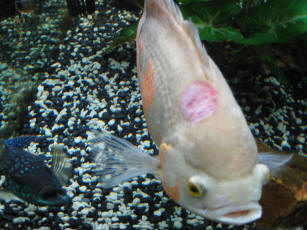
|
|
Re: Cichlids? 1/5/10
Chuck,
<Not here unfortunately... and you've sent some 17.5 megs
of pix... we ask that folks limit such to hundreds of
Kbytes...>
Here are some pictures it was really hard to take pictures of the
dark one.
<I can barely make out anything but in the one image>
I also wanted to give you a look of the big guys landscape
<Can't see any of this>
If they are not a spawning pair and "she" is sick, how
long can they be sick for?
<Can't tell from the information presented... See
below>
My husband tested the ammonia level, ph test and a nitrite test.
I hope this helps.
Thank You
Tiffany
<... the one fish appears to be a Cichlasoma festae... the
other? Maybe a Trimac... These may breed, but are more likely to
kill one or the other...
Read here:
http://wetwebmedia.com/FWSubWebIndex/neotropcicfaqs.htm
ALL the linked files above. Bob Fenner>
|
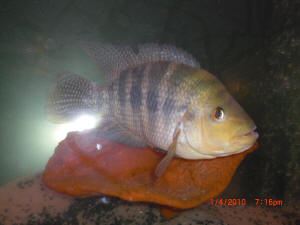 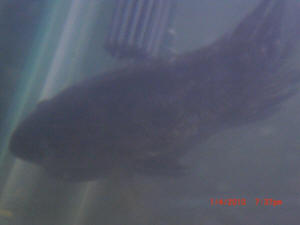
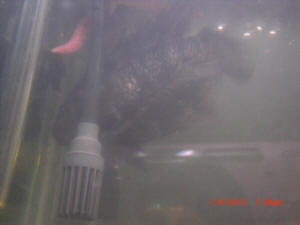 |
|
Re: Cichlids?
New World Cichlids Not Getting Along 1/5/10
Chuck, The big guy seems right, the other one has similar
markings and different fins. "She" was just a little
darker than him until we added about 15lbs. of black gravel from
the store. Right away "she" got dark.
My husband and I rinsed off the gravel before adding it to the
tank. Thank You Tiffany
< Your cichlids are Central or even South American substrate
spawners.
These look like adult fish that are very difficult to get to pair
up as adults. The female photo is not very good and I can't
even tell if it is the same species as the male. The male will
dominate the entire tank and will probably not get along with the
female as she will always be hiding in the corner. She will never
get enough food to become conditioned enough to spawn. I would
keep the male by himself and give the female? back to the store.
He will become very personable and actually start to react to you
when you come up to feed him. If you really want to try and spawn
them then that will take some effort on your part to force the
pair to spawn.-Chuck>
New World Cichlids Not Getting Along 1/5/10
Chuck, The pet store that we got these fish from said that they
came from the same place and lived in the same tank. They got
along fine until her stomach got bigger and the big guy started
attacking her. At that time he started rearranging the tank also.
Thank You Tiffany
< The pet store you purchased these fish from should have been
able to correctly ID these fish for you since they were in their
tank. Where they came from means nothing. At this point we can
make two assumptions. If you want to believe that these fish are
a pair and the same species then we can go from there. The
swollen belly on the female could be an intestinal infection.
This is caused by stress , like poor water quality bad food or
being picked on by a larger fish. To treat the fish with the
swollen belly I would recommend that the fish be isolated in a
hospital tank. Treat the tank with a combination of Metronidazole
and Nitrofuranace.-Chuck>
Re: Cichlids?
Cichlid With Probable Internal Infection 1/6/2010
Chuck, If the fish is sick, how long can they survive this
illness?
< You have a fish that is staying in the corner and does not
come out to eat. This internal bloating infection can last for
months.>
It has been over a month, going on maybe a month and a half. Or
how long do they carry their eggs for?
< Usually eggs get reabsorbed or the female will lay them and
just eat them right away.>
If we have to separate them, that's fine. She does spend most
of her day in the corner and when the light is out he does not
bug her nearly as much.
< Cichlids are visual creatures, out of sight then out of
mind.>
Also, why would he be making nests in the tank if they are not a
spawning pair?
< Cichlids define their territory by moving sand and gravel,
moving plants and even filters. This nest may be no more than
defining the limits of his territory.>
The pet store that we bought these guys from said that they did
not know the species
< If the pet store cannot identify the species then they can
possibly know anything else about them. Either they were too lazy
to look them or just didn't care.>
because they were given to them from some guy who was moving. He
supposedly gave them three. When we purchased them, they had been
living in two different 10gallon tanks. We had them here for at
least two weeks before all this belly action started. So, I told
my Husband that he should test the water when we first noticed
the belly and all three test came out fine.
< Water test result should be zero for ammonia and nitrites,
then the nitrates should be under 20 ppm.>
also, they got along fine before this happened. The pet store
owner also told has that they are mouth breeders and that if he
goes after her mouth that that is how they(these ones breed), and
y husband said it looked like they were kissing before. I just
want to get as much info as possible. I don't want
"her" to die on us.
Thank You Tiffany
< I can tell you for a fact that these cichlids are NOT
mouthbrooders. Some cichlids do some lip locking, like a test of
strength to determine the suitability of a mate. On the other
hand, cichlids can do this also just when they are fighting.. I
would recommend separating them and treating the female until the
swelling goes down. Once she is cured you can try to reintroduce
them together.-Chuck>
Re: Cichlids?
Treating Bloat In New World Cichlids 1/7/10
Chuck, How long do you think it will take to get her well?
< The key to a successful recovery is to treat the symptoms
early, with both Metronidazole and Nitrofuranace. It has taken a
few weeks for her to get this big, so it may take awhile for the
swelling to go down.>>
Also, how do we go about getting her well, besides separating
them? I know that they can not live (or should not live) in a 10
gallon tank, but do you think that that will be fine until she
feels better? That is all we have. Thank You Tiffany
< We have given you the best advice on how to treat this
problem. If you cannot follow all the advice then do what you
can. If it is impossible to treat her in a separate tank then she
may not recover. You have a long shot at saving her, even in a
separate tank. Keeping her with other fish will diminish her
chances at recovering.-Chuck>
Re: Cichlids?
Finding Medications for Cichlid Bloat -- 1/8/10
Chuck, I have tried to look for these medications and I am unable
to find them. Do you guys sell them off of your web site? If not,
do you know where we can purchase them.
Thank You Tiffany
< Check out Drsfostersmith.com -Chuck>
Re: Cichlids?
Bloated Cichlid Starting To Eat 1/11/10
Chuck, I wanted to say thank you, I did order the medicine. Also,
I wanted to tell you that last night and today she has been
swimming around as long as the light is off and she did eat last
night. We will not get that medicine until the end of next week.
Thank You Tiffany
<If the female is eating and starting to swim around then this
is a good sign.-Chuck>
Re: Cichlids?
Cichlid With Large Stomach 1/23/10
Chuck, Hello, We put the females fish into a separate tank, and
she seems ok. We are not sure if she is even sick. She attacks
the tank when we go up to it. She also seems to be eating, but
her stomache is still bigger than when we bought her. Thank You
Tiffany
< Glad to hear that your fish is acting normal and eating. Cut
back on the food. Feed once a day and only enough food so that
all of it is eaten in a couple of minutes. Remove any uneaten
food. This may reduce the stomach size.-Chuck>
|
|
Tank help
Cichlids With Hole-In-The-Head 7/1/09
Hello WWM crew, My name is Ryan. I was referred to your site from
Brian MacDonald "The Fishman".
He came out to look at my tank and get my water chemistry back on
track, (my pH and alkalinity were always bottoming out) which we
got to a 7.0 for pH and a good rating (120-180) for the
alkalinity. My tank is 210 gallons, with 2 Xp4 Filters (added an
extra one almost 2 weeks ago now as per Bob's advice to
Brian) 2 Power heads, 2 heaters. Water temp is always 80. One of
the filters has a snorkel attachment on it which I use on full
tank till I get any scum on the surface then I switch it for
about 30 min to full skim then put it back, while the other Xp4
has the factory blue downspout.
My Fish include: 2 Tiger Oscars, 4 Jack Dempsey (3 female 1 male,
which have had eggs 3 times now) 2 Green Terrors, 1 Convict, 1
Green Severum, 1 Parrot, 1 Royal Pleco, and 1 Leopard Sail-fin
Pleco.
2 Pictures of my tank with the canopy off are on Brian's site
http://www.carefreeam.com/testimonials.html (these pics were
taken before I added the 2nd filter)
I feed them Hikari Bio Gold Large pellets, Hikari Gold smaller
pellets, Tetra Pro Flakes (the ones that don't break apart)
Hikari Blood Worms, Sally's Brand Frozen Krill, and Hikari
algae wafers for the Pleco. I feed 2 times a day the pellets
(which I switch up day to day to keep them interested) and
sometimes instead of pellets the second time of the day I will
add one of the frozen food, a few blood worms or some krill. When
I turn off the lights I wait for about an hour and then I will
throw in some algae wafers, but that is only maybe 2 times a
week.
Also I feed them live earthworms as a treat when I get them from
the gardens, with my worm catcher. My cleaning schedule is 2
times a week Monday and Thursday water change and gravel clean,
service the 2 filters every 2 weeks, and change the micro filter
pads and the 4 bags of carbon (2 in each filter) every month to a
month and a half depending on how dirty they both are in the
rinse off process.
I was using a lot of Cycle product but after reading on your site
I have stopped using it and as well as the Nitra Zorb pouches I
was using in the past.
(Great info on your site)
Now with the stepped up water and gravel clean, those two
products are not needed. Thanks for saving me lots of money.
OK after all of that back story this is my problem, after keeping
the tank nice and clean and doing this scheduled maintenance for
about 2 months now, If and when would I notice the fish to
recover from Hole in head disease?
The 2 Tiger Oscars were given to me around a year ago, and they
were kept for about 7-8 months in really poor conditions at the
other guy's house, which I rescued them from. They both were
in bad condition, but the whole time I have had them they have
come back and have grown double in size. They both suffer from
Hole in Head disease, and I am worried my other fish will get it
or are getting it from them or my water. Brian suggested that I
send in some pics and contact you guys direct for some help
because he thought with my new schedule of water cleaning, they
should have started to heal up. Also I forgot to say but every
month I add some API aquarium salt to help them with the
electrolytes and healing. I am including 4 pictures of close up
night shots so they aren't moving, 1 of the 2 Oscars which
you can see there hole in head, 1 of the Severum with a line
running down his body I am not happy with, 1 of the female
Dempsey with the same
line forming as the Severum and 1 of my bigger Green Terror who
never seems to heal his 2 Pectoral fins, and he has them always
ripped and fluttering.
Every time one side seems to heal for him his other is torn. So
thanks for letting Brian know I needed better
filtration already. I am so glad to have people who know what
they are talking about helping me since I was lied to and pretty
much screwed by the Big Al's people of Brampton into spending
about $2000 in chemicals and Nitra Zorb and Cycle and pretty much
anything else they could sell me, and not ever get my tank into
proper standing, as your site and Brian's help did. So Please
let me know what to do from here, and thanks again.
< Check the nitrates regularly. You are feeding lots of
different foods which is very good, but these materials create
lots of nitrogenous waste. The ammonia and nitrite concentrations
should always be zero. The nitrates should always be under 20
ppm. If the levels exceeded this limit you need to do more
frequent water changes, change more water when you do your water
changes or reduce the bioload by having fewer fish. The
alkalinity issue you are having may be a sign of your problem.
You fish may not be getting enough calcium in their diet. I have
a theory that calcium is not found in soft acidic water. Fish
found in these areas need to get the calcium from their diet
since there is none to be found in the water. If you water is
very soft and you have alkalinity problems then the problem may
be that their is not much excess calcium to build and replenish
bone structure. The skull is s very large bone on the fish and
may be the first sign of a calcium deficiency. Many people who
make their own fish food have added calcium to their fish food
recipe and have had some success. Many of the foods you are
feeding are very high quality but usually have high protein
amounts that encourage grow. Growing fish need lots of calcium
for growing bones. You could try to add some crushed coral to the
tank to increase the calcium content of the water and try to get
the alkalinity up to 200-300 and see what happens. This disease
is very common on large new world cichlids but seems very rare on
African Rift lake cichlids of similar size. The pH of the lakes
is well above 7 with alkalinity well above 300. Some treat the
fish with Metronidazole. This may he a case of treating the
symptoms and not the disease.-Chuck>
|
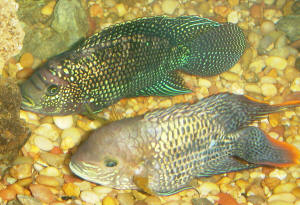
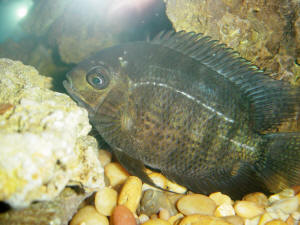
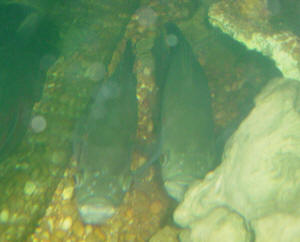 |
|
Green terror 6/25/09
Don't know if there is anything wrong' but my terror
looks like he is cut on both sides of his body. Here is a pic
<Difficult to say, the images are too blurry. What is your
Aequidens rivulatus living alongside? They are aggressive fish,
but there are fish that are more aggressive, so in a small
aquarium without room for all the
territorial fish, injuries are likely. In any case, I would hold
off treating if the damage was purely superficial, i.e., just a
scratch and a few lost scales, but keep your eyes open for signs
of Finrot or Fungal infection, and if those arise, treat as
necessary. Cheers, Neale.>
|
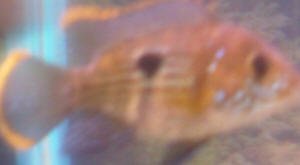 |
Cichlid
Tank... induced troubles 6/17/09
Hi Crew
<Brian>
I have a friend that has a 210 gal cichlid tank, he has 2 Oscars, 4
jack Dempseys, 1 convict, 1 parrot, 2 Plecos & 2 green terrors.
<Quite a mix>
He has water issues of course, he was only doing water changes &
gravel clean every 2 weeks.
<I'd do weekly>
His Oscars have hole in head disease which of course is probably caused
by poor water quality.
<Very common cause, along with nutrition>
We did a 25% water change & gravel clean and i told him to step up
his water changes & gravel clean to twice a week till he cycles his
tank then do it weekly.
<... the system is not cycled?! I'd do more to move this
ahead... have him read on WWM re.>
He has an XP4 Rena canister filter with a flow rate of 450 GPH which I
think is not enough.
<It is not>
He has 2 power heads & surface skimmer hooked up to his filter.
<Of help, but...>
We live in Toronto which has good water quality Ph 7.0 and moderate to
hard water out of the tap.
Now he has a feeder tank for feeder fish which I told him to stop
because of the chance of disease in his main tank, with that being said
his feeder tank has a white fungus around the top of the tank on the
top framework of the tank.
<... dismantle this tank, eschew using feeder goldfish...>
He also said that when he put in his feeder fish, within an hour the
fish were infected and covered with this fungus.
<!!!>
I told him to empty the tank and scrub it with a stiff brush and leave
it empty for a month or so, will this kill the fungus.
<Leave it empty period>
Also his filter in his main tank he had it jammed with 4 Nitra Zorb
packs & 6 Chemi pure charcoal bags along with his sponges & bio
media, we took out 2 Chemi pure bags but keep the 4 Nitra Zorb packs. I
am not a fan of Nitrate remover media I figure regular water changes
will take care of the Nitrate with his almost overcrowded tank &
his cichlids are large! Oscars probably close to 8" long!
<... Please... see WWM re NO3... You are in the service business...
should know better than this...>
Have any suggestions on filtration & the fungus problem, I figure
he should add another XP4 filter which would give him 900 GPH.
<See WWM re the first two and yes to the last>
Thanks everyone & keep up the good work, as usual!!!
Brian Macdonald
PS How was Bob's Trip to London, Ont?
<A very nice time, the 50th anniversary of the CAOAC... Gary Lange,
Heiko Bleher and I gave presentations, good folks to chat with... and
not-too-cold weather. To my scant awareness, very similar to
Toronto.
BobF>
CAREFREE AQUARIUM MAINTENANCE
Re: Cichlid Tank
6/18/2009
Hi Bob
<Brian>
Think there was a misunderstanding in my email about the cichlid tank
The poor guy dealt with a company that did everything wrong from
installation to their service & advice so he is a little gun
shy
<I see>
This was my first visit so I did my thing and he was very happy so I
told him about your site and said I would contact you about the fungus
& filtration so he could hear it from the BEST!
<Ah yes... best to have him search, read... write us directly with
his questions and concerns>
I am forwarding your e-mail to him cause he is fairly new to this but
really has a passion for his tank & wants to do the rite thing
Thanks Bob
Brian
<Welcome. BobF>
Black growth on bottom of
Cichlid 2/23/09 Cichlid With Black Belly Growth Hi there, Been
reading all sorts of great info on your site. Much appreciated.
However, I'm having a hard time finding my exact problem... We
adopted a single cichlid (perhaps midas or parrot? not sure) from a
neighbor who is having to split time between her place and her elderly
mom's place. At any rate, this cichlid named Quesadilla (or Casey,
for short) lives in a basic tank by itself and seems relatively happy.
However, it has developed a black growth all along the bottom of the
fish. It is acting relatively normal and seems healthy, but it seems
like sometime it is trying to rub up against the plastic plants or the
side of the tank. It doesn't seem like it's ich (which seems to
be described as white or black spots). I would describe it as a
"beard" and I did a search and found "black beard"
algae, but that seems to be something that affects thinks like
driftwood and other objects in the tank instead of the fish itself. It
isn't too fuzzy -- the fish just sort looks dirty. We've
changed the water recently, and put in a fizzy tablet for fungus a
couple days ago, but it still has this black stuff on the bottom of the
cichlid. Any ideas? Much appreciated. Thanks. regards, Ewan < Never
heard of algae growing on a cichlid. Sometimes when fish get bacterial
attacks their nervous system is affected and the fish turn black where
the attack is occurring. It could also be genetic. The black color
could be genetic but a "growth" can't be genetic. A photo
would be a big help. Fungus growth is usually white to grey. Do a water
change, clean the filter and vacuum the gravel to see if that
helps.-Chuck>
South American Cichlids With Bubble Like
Parasites Hi, I've been reading about all these people
with sick Severums, but none of them seem to have the problem I do. I
have one adult female green Severum and she has small bubble like bumps
on her fins. Roughly three on the dorsal, one on the anal, and twelve
or majority on the tail. They sort of look like small air bubbles
underneath the skin of the fins. They are almost white in color and can
vary in shape. These bumps never really worried me for years. Then two
of my fist died, and traded a third for some new fish. None of these
fish showed bumps or any real sickness. So then the new fish were added
in the 55 gal where I keep this green Severum with bumps. It was
outbreak. One of the new fish, a young Uaru, started showing signs of
the same bumps. I quickly pulled two other fish I had recently bought,
and put them in a separate tank. This left me with a green Severum and
a Uaru both with some sort of parasite and a royal Pleco (showing no
signs of disease) in a 55 gal. First I treated with copper safe. The
copper treatment was monitored very closely by me and the local
advanced aquarium specialist. The owner and very experience fish
aquarium hobbyist, if you can call it a hobby even though its a
business, said he had seen it before but on some needle nose gar. The
copper treatment failed but did manage to stop progression cure some of
the spots. Deciding to try something a little less stressful on the
fish I bought some General Cure or Metronidazole and treated the tank.
This had no effect. I was now determined to get rid of these bumps, not
really knowing if it had something to do with the two fish deaths I
mentioned earlier. I pulled both the Uaru and the Green Severum putting
them in a 20 gal. hospital tank with a sponge filter. I treated with
Formalin. I did this quit accurately and according to package
directions using a small syringe to measure. This I did for at least a
week but stopped when no progress or bumps were removed. At this same
time the fish store owner received on trade two Severums, one gold and
a green, both with similar bumps on the tail and fins. I gave my fish a
rest and he treated his with formalin, with no result, and then with
fluke tabs. I think after the third dose, and a very high dosing, he
managed to knock them all off even to his own surprise. I decided to
try it on my fish, but with no result on the green Severum. The Uaru
only had two or three to begin with, but appears to be rid of them.
I'm unsure what my fish is infected with, and if there is some cure
or remedy I'm unaware of knowing. The aquarium shop owner is
curious as well if I'm able to find any information. Any knowledge
or help would be much appreciated. < I suspect that you have a
parasite that is imbedded in to the flesh and fins of the fish and is
in somewhat of a dormant stage. The only way to know for sure is to
take a sample of the infected area and have a qualified vet look at it
under a microscope. This can be expensive and troublesome. Usually when
the parasites are under the skin they are protected from medications
until they emerge. I see this in wild fish more often than captive bred
fish. The key to a successful treatment may be in getting the parasites
to emerge so they can be exposed to the medication. You mentioned that
the store got rid of these bubbles using Fluke-Tabs but that it
didn't work on your fish. It may be that these parasites are
hibernating until they are stimulated by something to make them emerge.
Try raising the water temp to 85 F for a few days and then treat them
with the Fluke-Tabs. At this temp the water will have less oxygen
carrying capacity so monitor your fish and increase aeration as
needed.-Chuck>
45-40 then back to 45 New Cichlid Tank Problem... Poss.
Silicone sealant poisoning 1/16/2009 Hi WetWebMedia, I have a
bit of a problem. I have two tanks. One is about a 45 gallon and the
other maybe a 40 gallon. I have a blood parrot, bushynose Pleco, one
jd, and one yellow lab in the 45 gallon tank. Unfortunately my 45
gallon tank had a leak, so I had to fix it. I moved my fishes into the
40 gallon tank with the cycled water and they seemed fine, eating and
active. I tried fixing the original tank and it took me about a month
to fix it and I used clear silicone glue. After I fixed it, I added in
the cycled water from the 40 gallon tank to the fixed 45 gallon and
then added 5 more gallons of tap water, which I treated with tap
conditioner. I put the fishes in the 45 gallon tank and they seemed
fine. However, I checked on them today again and they seemed very
lethargic. They sit at the bottom with their fins drooping down. They
don't eat and look sick. They do still respond when I tap on the
glass however. Is this do to the sudden change and stress they had to
go through, or i did I accidently kill too many of the beneficial
bacteria in the tank. What should i do? Thanks so much for all your
help and time. ~Chris < I would first do a water quality check and
get readings on the ammonia, nitrite and nitrate. The ammonia and
nitrite should be zero. The nitrates should be under 20 ppm. All of
these can be reduced by doing water changes. Adding Dr. Tim's One
and Only will establish the needed bacteria to break down the fish
waste to nitrates very quickly. The silicon needs to be used
specifically for aquarium use. Hardware store silicon usually has some
sort of fungicide or mildewcide in it that can be toxic to
fish.-Chuck>
please help New Cichlid Tank II 1/16/2009 Please
help WetWebMedia. My fishes are swimming upside down now and I
don't know what to do. In my previous e-mail, I told you about the
45 gallon tank to 40 and back to 45 again. However, I forgot to mention
that before I switched the 40 gallon to 45, I did a 20 percent water
change, then added the 40 gallon water into the 45 and then added the 5
gallon tap. Sorry if this is confusing you. Anyway, I am really worried
and I don't know what to do, my fishes are going to die, without
help. thanks <I would recommend a 25% water change to see if that
makes any difference. Please to check the ammonia and nitrites. I
suspect that these are your main problems right now, especially if the
filters were cleaned between transfers.-Chuck>
Re: 45-40 then back to 45 Buying Silicon For Tank Repair
1/16/2009 Hi again, i was just wondering, what types of
silicone are toxic, and what should i do? Will it eventually fade away
and be fine, or do I have to redo the whole tank? Thanks. < When you
buy silicon you need to look at the labels for a silicon that is stated
that it safe for aquarium use. This is usually sold at aquarium shops
and sometimes sold at hardware stores. Most of the silicon sold at
hardware stores is for use around bathrooms and sinks. It is used in
areas that are prone to mold. They add an ingredient to prevent mildew
and fungus from growing. Look at the brand of silicon you bought and
look for a website. Look up the website and try to find a contact. Ask
them about the their silicon and if it is safe for aquarium use. I
would still do water changes to dilute any toxins and probably add some
good quality carbon to the filter.-Chuck>
|
Sick Redhead Cichlid (Vieja synspila;
health) 11/18/08 Hello, I have a 75 gallon tank. I have
had the tank established for approx. 8 months. I have a 6"
Redhead, 3.5" Convict, 4.5" Green Terror, 4.5"
Jack Dempsey, 3.5" Jack Dempsey, 3" Jack Dempsey &
3" Fire mouth. I test the water myself since I do not trust
PetSmart for anything & water tests are good, I keep the temp
at 80 degrees & I did a cleaning 2 weeks before my Redhead
was ill. <Water is a bit on the warm side. Is there any good
reason to keep it so hot? Remember, more heat = less oxygen. By
default, 25 C (77 F) is fine.> Which was the first time I
didn't include aquarium salt from a friends recommendation.
<Correct. Central American cichlids don't need salt,
though many tolerate salt extremely well, even to the degree of
living/breeding in saltwater habitats such as mangroves. The main
thing with Central Americans is water chemistry. Most need hard,
basic water, not unlike the livebearers (which are from the same
part of the world of course). Adding a bit of marine salt mix
(rather than cooking/aquarium salt) can raise the pH and
hardness, and may be useful in places where the water is soft and
acidic. But I'd sooner recommend the use of something like
Malawi Salt mix, perhaps at a half-dose, to harden the water.
You're aiming for pH 7.5-8.0, hardness 15-25 degrees dH.>
My Redhead is usually extremely stunning looking, a creamy color,
with orange, pink, lavender with some black spots towards his
tail. Three days ago I noticed my Redhead was eating, then
spitting it out. I didn't think anything of it until the next
morning when I found him shaped like a "C", in his
house, very dark in color with a dark olive greenish face, very
dark pink on his head & around the gills, up side down,
breathing heavy at times & his eyes are usually a beautiful
blue but now they are black in color. I did a little online
research, the past 2 days I cleaned the gravel, did a 20% water
change, added the normal chemicals, added aquarium salt,
gradually turned up the heat to 82 degrees & darkened the
tank with news paper on his side since it seemed like the light
irritated him. <Hmm... would not normally have reacted to this
by changing water chemistry. Almost always better to do a
pH/hardness test, and then do a 50% water change, ensuring pH and
hardness don't change. The exception here would be if there
was a dramatic pH drop, in which case a series of smaller water
changes across the day to revert the pH to where it should be is
recommended. When cichlids go "black" suddenly,
it's almost always an environmental thing -- temperature, pH
typically -- and so your job is to compare the current readings
with what they normally are, and then act accordingly. The other
option is a social thing, with the "black" cichlid
somehow suddenly finding itself at the receiving end of some
major aggression.> Today I noticed his fins are a bit ragged
but not fin rot & he either injured one of his eyes from the
occasional roll over in his house or has some kind of swelling
starting over it. <OK, when one eye gets damaged, aggression,
or at least physical damage, is likely the cause.> Late last
night I lost hope, I got the bucket ready with water & had
the packets of Alka seltzer ready. I went to get him with the
large net & to my surprise he rolled to the other side of the
tank. I figured if he had that much fight in him that he deserved
a chance. My other fish seem to be fine, I fed them a few pellets
one day then blood worms the next & they all ate with no
problems. I do not have another tank to quarantine him & he
has not attempted to eat. I have been thinking of all the
possible causes, the last week I have left the canopy open &
I do not have a glass lid under it & the tank is about 10
feet from the front door, which the weather has been rainy &
a bit chilly. I am very upset & looking for help for the big
guy, thanks, Gina <Gina, I'd be running down the list of
environmental and/or behavioural issues in the tank. Cheers,
Neale.>
Re: sick Redhead Cichlid (Vieja synspila;
health) 11/19/08
Thank you for your help.
<Happy to help.>
I did go to PetSmart before your reply & spoke to an employee
that seems to know a lot about fish (I should I say a lot more
me,) since she said she has 11 aquariums of her own. She
didn't really know why my Redhead is sick, which is totally
understandable, but she did suggest T.C Tetracycline.
<Tetracycline is a general purpose antibiotic. It's a
"scatter-gun" approach, the idea being it'll cure a
bunch of stuff (though not
everything) without you needing to identify the actual
disease.>
I followed the instructions & treated the my tank once so
far. Per the instructions I need 3 more doses, so I am going back
to purchase them. The only change is that the water changed color
& my Redhead is still not moving or eating, he is staying in
his home on the bottom, but he did roll on his side & up
right for a couple hours then he rolled on his back again.
<Do follow instructions, in particular remembering to remove
carbon from the filter, if you use carbon.>
I am gradually changing the water to 77 degrees, today 79
degrees. I have been watching my fish to make sure they are not
aggressive towards my Redhead & they have been with him a
lot, but not at all aggressive even as sick as he is. His life
long tank mate my male Green Terror still stays by his side. I
checked the water myself & even though the sticks say
"safe" or "ideal" they are not what
you've recommended so I am going to bring my sample to
PetSmart for them to give me the correct results & I can
start to follow your instructions. The 1st nitrate is 0-20
(closer to 0), the 2nd nitrate is 0 (both state ideal), the
hardness is 75 soft, the chlorine is 0, the alkalinity is 40, the
PH is between 6.8 - 7.2.
<Ah, well, Central American cichlids across the board like
hard, basic water. While I doubt this is specifically what's
making the fish sick, it could *easily* be a stress factor that
weakens the immune system of your fish, allowing secondary or
protozoan infections. Vieja synspila has some tolerance of
brackish water, so adding a small amount of marine salt mix (as
opposed to tonic/aquarium salt) could be used to slightly buffer
the water. Don't use more than 6 g/litre.>
I am going to attempt to add some photos for you to see, (my
video was not very good), in case I am explaining things
incorrectly or if you have seen this happen before. The 1st photo
is 2 weeks before he was sick, 2nd photo is the 1st day being
sick & the last two photos are 5 days sick after the 1st
treatment of TC Tetracycline. Can you tell if he is getting
better or worst? How long do I leave him in this condition &
what signs should I look for that would tell me if he is getting
better or worst?
<When fish roll onto their sides, that's normally not a
good sign... In any case, continue treatment, and slowly, raise
the pH and hardness by adding a small amount of Malawi salt
(maybe a 50% dose) or else a little marine salt mix. With luck,
the fish will recover. Good signs are normal rather than heavy
breathing, proper posture, and normal rather than clamped
fins.>
It is nice to know there are people that care enough to help, I
can't thank you enough,
Gina
<Good luck, Neale.>
|
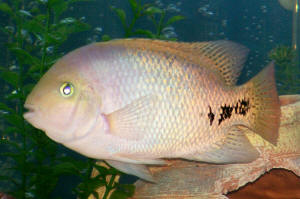
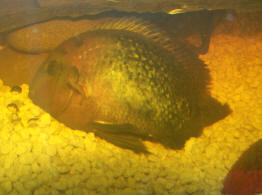 |
|
Re: T-Bar Cichlid, hlth., sys., fdg....
English? 8/16/08 Hello, You told me to raise my water
temperature he seems to be a little better, like him chasing
other tank mates around. When I give him frozen brine shrimp he
tres to eat it then spits it back out. He seems to be completely
black in colour, really skinny and gets tired really easily. What
could I do to help him? Thank you for your time. < Frozen
brine shrimp has almost no nutritional value, so I would
recommend a high quality pellet food instead.-Chuck>
Re: T-bar cichlid problem thank you for
your email so what type of pellet would you recommend thank you
again for your help <Ditto this one! Please, use capital
letters at the beginnings of sentences, full stops (periods)
where they should be, and what the heck push the boat out and use
commas if you want. Cheers, Neale.>
Re: T-bar cichlid problem What type of
pellet should I get? Thank you. <There are many good foods for
Central American cichlids. Since they're most omnivores,
using a mixed diet is best. But as a staple pellet, try something
like Hikari Gold. Augment with feedings of chopped mussels (good
combo of meat and algae), tinned peas, cooked spinach and frozen
bloodworms. Live brine shrimp are fine as treats, and provide
useful fibre, but not much else. Once a week would be fine. Do
remember not to overfeed your cichlids: they will always *seem*
hungry, but they don't need as much food as they'll eat!
Overfeeding, and consequent water quality problems, especially
re: nitrate, are much more serious, leading to things like
Hole-in-the-Head. Cheers, Neale.>
Re: T-bar cichlid problem Thank you for
your email. <Happy to help.> Well I bought Hikari cichlid
gold today and I have JMC high protein fish food an frozen brine
shrimp. <Very good.> Do I need to get any other foods
because they all seam protein foods? <As mentioned before:
greens! These cichlids are all more or less omnivorous, which
means they MUST have plant food as well as meaty foods. This is
easy to cater for, as described earlier.> Thanks <Cheers,
Neale.>
Re: T-bar cichlid problem Thanks for your
email. Do t-bars eat lettuce and cucumber? Thanks <If
they're hungry, cichlids will eat anything! But lettuce
isn't recommended; it contains no nutrition at all. Much
better to go with tinned peas, or better still, strips of Sushi
Nori. You can buy Sushi Nori in bags of 10 sheets for about 1 UK
Pound (convert to your local currency) and that'll last you
months. Tear off small pieces, and attach to a lettuce clip or
use a rubber band to attach to a stone. Both Sushi Nori and
tinned peas are nutritious, safe, and very cheap (you can freeze
any tinned peas you don't use, and just defrost a few
whenever you need them). Sometimes cichlids will ignore plant
foods: don't give in! Let them starve a day or two; it'll
do them no harm and much good. Cheers, Neale.>
Re: T-bar cichlid problem 8/16/08 Thanks
for your help I will get peas because if I got the sushi Nori my
Uaru would eat it all and gard the place I put it (which it used
to do with the lettuce). <So offer both! The Uaru is a very
herbivorous cichlid, and does need regular feedings of green
foods. If you must use lettuce, don't use iceberg or anything
red or funky; use old fashioned green, curly lettuce.> How
often should I feed them peas? <As often and as much as they
want. Squishing the peas helps the cichlids figure out what they
are. Green foods do little to no harm to water quality.>
Thanks for all your help. <Cheers, Neale.> Thank you for
your help. You have helped me a lot. Thanks again!! <You are
most welcome. Cheers, Neale.>
|
Cichlid Mystery... Neotrop., sys., hlth., fdg., beh. 8/6/08 Re:
Cichlid Mystery Wild Florida Cichlid Problems (Chuck's Second
Opinion) 8/6/08 Hello Crew, hope you have some insight for me, for
I am mystified. I have a 20 gal tank with a single specimen Mayan
Cichlid (False Red Terror). <Are we talking about Cichlasoma
urophthalmus here? Obviously this species, getting to 40 cm in the
wild, is far too large for a 20 gallon tank.> < This fish is
commonly found in Florida,-Chuck> I've had it since it was the
size of a penny; he (theoretical; only going from how bright salmon red
he gets when showing off) was netted out of the actual Everglades
(where they are an invasive species), and he is now about a year and a
half old, and about 5-6 inches long. He is fed a variety of foods:
Hikari Gold cichlid pellets, dried Gammarus shrimp, dried bloodworms,
live Ramshorn snails and occasionally, live Gambusia and Mollies from a
large 65 gal Everglades tank I have in the Florida room, also the
source of the snails (and home to a 8-inch Orinoco Sailfin Catfish that
I thought was a tadpole once.) ALL his live foods are grown by me, so I
have no fear of contamination that way. <Still, I'm leery of
using wild-caught fish as food because you're running the risk of
introducing parasites that don't normally occur in aquaria and so
end up being difficult to treat. As you may/may not know, many
parasites pass through multiple hosts, for example a small fish, then a
bigger fish, and then a predator bird, then out with the birds faeces
into the pond and back to the small fish. Because this cycle can't
occur in aquaria or fish farms, these parasites don't normally
occur in tropical fish tanks. If you have a fish that happily eats
prepared and frozen foods, why take the risk?> So far he is the
textbook definition of a Mayan, charging the side of the tank anytime
you walk by, and sometimes attacking his own reflection for hours at a
time, unless he is hiding behind the huge water sprite planted in
there. <OK. These are nice fish; kept one in a high-end brackish
aquarium for a long time. They thrive in brackish/marine conditions,
and are arguably more mangrove swamp cichlids than anything else.> I
went away for 5 days for vacation, so I stuffed his tank with snails
and food fish, and had someone feed him some of his pellets about two
days before I came back so he wouldn't starve. <OK, here's
the first problem. NEVER, EVER "stock up" a tank with food. A
healthy small fish like a Neon can go a week without food NO PROBLEMS.
A big healthy fish like a cichlid can go two weeks or more without
food, and in the wild would have to periodically anyway. In other
words: it is better to leave your fish hungry during vacations than the
alternative, which is to risk overfeeding them (or having them
overfed). Too much food = too much ammonia/nitrite, and that leads to
stress.> I came back only to find him lying on the bottom of his
tank, in a hole he'd cleared out, looking the palest I've ever
seen... his eye-spot was white, and he was still for hours. He had
re-arranged his pea gravel extensively, which makes me think he might
have been looking for snails. <Hmm... more likely displacement
activity. When animals can't do one thing, because of stress or
some other factor, they will sometimes do some other, unrelated
activity. Humans biting their nails is the classic example: nothing to
do with being hungry for protein!> Much testing of water ensued, to
no answers... pH is 7.2, ammonia 0, nitrites 0, nitrates under 20 ppm,
tank temp is 78, water is general hard, absolutely nothing happening
there. <Ah, but you misunderstand. The nitrite/ammonia spike could
have easily occurred day 1 after you left, and by now the filter has
removed them both from the water, but the fish remains stressed.>
The tank is acrylic 20 gal, has an Eclipse 2 (capacity much higher than
20 gal) filter top with bio-wheel in perfect working order and seeded
with my own bacteria from other tanks., and there's plenty of
aeration in the tank. The tank water gets changed weekly along with all
the other tanks. <Still too small. These novelty filters that fit
the hood are maybe fine for small tropicals like Neons but have no
place in the cichlid aquarium. Too much space is given over to compact
cartridges contains junk you don't need like carbon and Zeolite.
Not enough space is given over to mechanical media and especially high
performance biological media (ceramic noodles). Complete waste of space
if you ask me. You should be using a decent canister filter rated at 6x
the volume of the tank in turnover per hour. For this species of
cichlid a 20 gallon tank makes no sense at all, and long term
you're going to find this fish increasingly difficult to keep
healthy.> After testing and re-testing and finding nothing to
correct, I went and fished out a few snails and threw them in, in hopes
that he'd become more animated. <No, doesn't work this way.
When fish are sick or off-colour, you don't feed them. You run the
risk of making a bad situation worse. A healthy fish -- particularly a
cichlid! -- will be begging for food once hungry.> After a few hours
and his lights turned off (on a timer, mind you), I could hear the
clicking of snail shells against the tank, so I knew he must be feeling
better. The next day, after the snails had been eaten, I tossed a few
Gambusia in there. It's been 2 days, and he is back to normal,
charging the side of the tank every time someone walks by, attacking
his food and patrolling his tank, flashing his stripes when he's
aggressive or just turning brilliant salmon if I get near... What do
you guys think happened? My theory is he might have knocked himself out
charging his own reflection, but any and all advice is greatly
welcomed. Maybe he missed me? <Suspect a water quality crisis in
your absence.> Carol <Hope this helps. Have cc'ed Chuck, our
cichlid guru, for a second opinion. Cheers, Neale.> < Sometimes
in the dark, fish get spooked by shadows. In a small tank where there
is no place to hide it could have damaged himself on an object or on
the tank himself. As per Neale's recommendation a larger tank is in
order for the best concerns of your Mayan Cichlid.-Chuck>
Bloated Green Terror -- 04/19/08 Hey
chuck. Its me again. I have a female green terror. She been recently
ill? Can you please tell me what kind of sickness she has? She normally
swims around and eats. These past few days she's been looking very
ill. Her stomach looks like its going to blow? Her scales on her
stomach is peeling a bit. She just stay in one spot for ages. She gets
scared by other fish really easy and get chased sometimes? Her stomach
was never that big. She never eats at all now. Before illness she use
to eat normally. What should I do with her to get her better? Is she
going to die? do I need to put any specific medication? Is there A
chance that she could be laying eggs? If so shouldn't she be really
aggressive? She doesn't have a partner though..? She stays with 5
other cichlids, such as Flowerhorn and red devil. Thanks . eric (any
information would be appreciated) thanks chuck. < Your green terror
female has an internal infection. It could have been caused by poor
water quality, poor diet or stress. Start out by doing a 50% water
change, vacuum the gravel and clean the filter. Treat with a
combination of Metronidazole and Furanace. Do a search on the WWM
website for bloat or dropsy to get opinions from fellow WWM crew
members. This is fatal if not treated early.-Chuck>
| Help with my fish please... FW... Neotrop.
Cichlid... hlth. 3/30/08 Hi. I tried to find information on
your website, but my English is not so good so I had problem
finding the answers to my questions. <Let's see if we can
help then. If I say something that doesn't make sense, please
write back and I will try and explain better!> I have an Oscar
and a Jack Dempsey. We changed aquarium 5 months ago for a 50 gal.
At first, the fish were fine, but 2 months ago, some brown dirt
start to "growth" everywhere in the new aquarium (see on
picture) <This is just Diatoms. A kind of algae. Harmless. Wipe
away with a clean cloth or sponge. Fish won't eat it, so adding
a catfish like a Plec is pointless.> and the fish start feeling
bad. Oscar stars having a wound on his head. <Yes, I see. This
is a bacterial infection. Essentially an ulcer. Sera Baktopur
should help. But I personally prefer eSHa 2000, a Dutch medication
that seems to work very well against bacterial infections. If you
were in the US, then you would probably be using an antibiotic like
Maracyn (Erythromycin). You may want to visit a veterinarian to get
some of this medication if you are not in the US.> I treat the
water with "Baktopur" twice. (I send you picture of
before and after the treatment.) <Certainly helping, and
there's some new skin growing back. But this infection is
caused by physical damage (e.g., a bite) or poor water quality.
Perhaps both. So: check the fish are getting along. Also make sure
the water is clean. Nitrite = 0 mg/l, Ammonia = 0 mg/l. Ideally the
Nitrate should be < 20 mg/l but certainly < 50 mg/l. The
filter must have turnover of at least 6 times the volume of the
tank in gallons per hour. In other words, your filter should be
rated at about 300 gallons per hour (or about 1200 litres per
hour). Do lots of water changes, 50% per week.> Now, 2 weeks
after the treatment, both fish are still sick, the brown thing is
staying even if we clean the aquarium and even if we change water.
They stop eating, they are about to die and I don't now what to
do. <Stop feeding the fish for a few days so that water quality
stays good. Keep using medication. Do big water changes!> thank
you for your help Stephanie, Oscar and Jack <Hope this helps,
Neale.> |
|
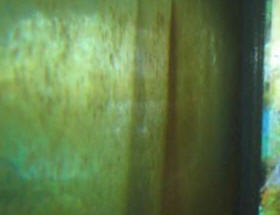 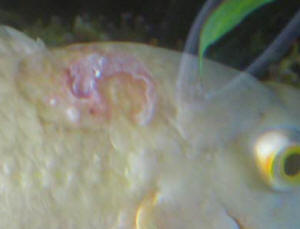 
|
|
|

